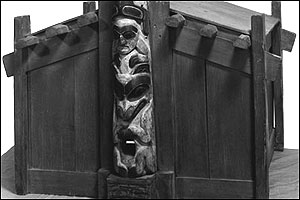|
Help UW art historian find missing Haida house models
Art history professor and Burke Museum curator Robin Wright
is trying to track down 14 hand-carved Haida house models
that have been lost for over 50 years.
 |
|
This model of "Box House" was made by Haida artist Tom Stevens for exhibition at the 1893 World’s Columbian Expo in Chicago. It is currently at the Brooklyn Museum, but its frontal pole is missing. Read more about this model below. Photo courtesy of the Brooklyn Museum.
|
|
Originally created
for the 1893 Chicago World's Fair, the models were part of
an exhibit on Northwest Native American arts and culture.
Fair organizers hired Haida artists from the village of Skidegate, BC., to make the models, which were based on real Skidegate houses and totem poles, and depict Haida family
histories and clan crests.
“Each one of the houses is a fascinating piece of cultural
history and a work of art,” says Wright.
Wright has been able to locate 15 of the houses so far, and
she hopes that people will contact her with information
about others.
“The missing models could be in someone’s
attic or basement, or maybe someone’s private collection,”
says Wright. “I’m hoping someone will see the houses online
and recognize them.”
The model houses are about 3 feet square, and the frontal
poles are from 3 to 5 feet tall. The houses and poles
may have become separated over time. Wright
thinks the poles are more likely to have survived,
because they’re more compact.
More about the house shown in the photo on this page
The Haida artist Tom Stevens (b. 1837, d. 1902), who held the chiefly name tl'aajaang quuna, made this model of "Box House" for exhibition at the 1893 World’s Columbian Exposition in Chicago. A brown bear with the house doorway in his belly sits on a box at the bottom of the pole, with a fisherman named "Skulsit, a whale and Raven wearing a ringed hat at the top, but the frontal pole is missing. Stevens based this model on a full-sized house in Skidegate, B.C., that belonged to him.
| 
